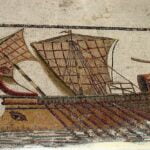Chapters
Ammianus Marcellinus, author of Roman History (Latin Res gestae), thanks to whom we know history very well The Roman Empire in 353-378 CE, holding many state functions and being a participant in such significant events of the world than as the siege of Amida and the expedition to Ktezyfont Emperor Julian the Apostate, no in his work, he merely described this type of military-political events.
From his account, we also know the cataclysms that struck the Empire in the middle of the 4th century CE. Ammianus writes about the earthquakes: in Syria on May 18, 363 CE, in Thrace and Asia Minor in December of the same year, a huge earthquake in the eastern Mediterranean on July 21, 365 CE and the earthquake in Lusitania in 382 CE The largest of these, with a magnitude greater than 8.5 on the Richter scale, was in 365 – arguably the largest Mediterranean earthquake in the first millennium CE, and perhaps even in the entire history of the region. This is not a disaster as known as the eruption of Vesuvius and the destruction of Pompeii and Herculaneum, but it certainly deserves more attention than it is today.
Destruction
Earthquake at dawn on July 21, 365 CE had an underwater epicentre off the west coast of Crete. The resulting tsunami devastated the shores of central and eastern Greece, Cyprus, Sicily, Libya, Egypt and the rest of the eastern Mediterranean. According to Ammianus Marcellinus, the water, lifting ships and thousands of killed people, e.g. in Alexandria, broke about 2 miles inland (about 3 km). In Crete, the nearest epicentre, almost all settlements located by the sea were destroyed. Due to the greatest damage and the proximity of the epicentre, the catastrophe itself is sometimes called a “Cretan” earthquake. As a result of the tsunami wave, the port and a large part of the cities of Apollonia and Sabratha in today’s Libya were sunk. Traces of destruction are also found during excavations in the western part of the Mediterranean coast, e.g. in the ruins of Neapolis, in today’s Tunisia. The catastrophe left a big mark on the people of that time and on the next generations. Even at the end of the 6th century in Alexandria, the day of the catastrophe on July 21 was referred to as “the day of horror” or “the day of fear”.
Geology and reception of contemporaries
The quake of 365 CE was caused by the high seismic activity of tectonic plates in the Eastern Mediterranean between the 4th and 6th centuries CE. It was also the largest in a series of quakes that hit the border of Asia, Europe and Africa at that time (only a few years earlier – in 363 CE the earthquake occurred in Palestine, Syria, Bithynia and Thrace). As a result of the cataclysm of 365, the island of Crete itself probably rose by as much as 9 m.
People of that time tried to explain to themselves what was the cause of such a great cataclysm. This is manifested in the writings of ancient Christian and pagan writers who tried to explain earthquakes with the wrath of God or pagan deities. It was supposed to be a punishment given to people for their sins (e.g. Emperor Julian the Apostate, who died 2 years earlier, tried to restore the glory of pagan cults) or, from the pagan point of view, a punishment for departing from ancient beliefs. Some writers, especially in later centuries – after the fact, interpreted the cataclysm as a warning against civil wars, barbarian invasions and the fall of the Empire.
Testimony of Ammianus Marcellinus
Below is a translation of Ammianus Marcellinus’s message about the Cretan earthquake in 365 CE (Res gestae, Book Twenty-six):
(…) on the twenty-first of July in the first consulship of Valentinian with his brother, horrible phenomena suddenly spread through the entire extent of the world, such as are related to us neither in fable nor in truthful history. For a little after daybreak, preceded by heavy and repeated thunder and lightning, the whole of the firm and solid earth was shaken and trembled, the sea with its rolling waves was driven back and withdrew from the land, so that in the abyss of the deep thus revealed men saw many kinds of sea-creatures stuck fast in the slime; and vast mountains and deep valleys, which Nature, the creator, had hidden in the unplumbed depths, then, as one might well believe, first saw the beams of the sun. Hence, many ships were stranded as if on dry land, and since many men roamed about without fear in the little that remained of the waters, to gather fish and similar things with their hands, the roaring sea, resenting, as it were, this forced retreat, rose in its turn; and over the boiling shoals it dashed mightily upon islands and broad stretches of the mainland, and levelled innumerable buildings in the cities and where else they were found; so that amid the mad discord of the elements the altered face of the earth revealed marvellous sights. For the great mass of waters, returning when it was least expected, killed many thousands of men by drowning; and by the swift recoil of the eddying tides a number of ships, after the swelling of the wet element subsided, were seen to have foundered, and lifeless bodies of shipwrecked persons lay floating on their backs or on their faces. Other great ships, driven by the mad blasts, landed on the tops of buildings (as happened at Alexandria), and some were driven almost two miles inland, like a Laconian ship which I myself in passing that way saw near the town of Mothone, yawning apart through long decay.







